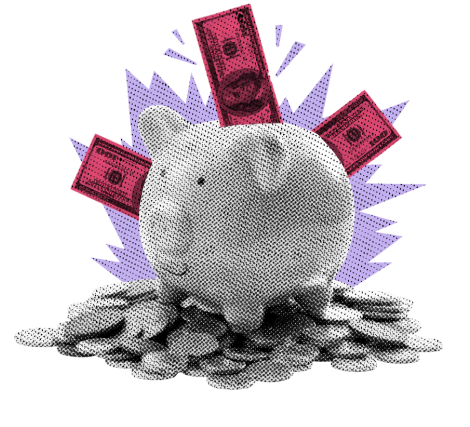
Tariffs are back, and they’re expensive. Inflation, GDP hits, and market uncertainty—here’s what you need to know.
KEY TAKEAWAYS
- Tariffs are paid by U.S. businesses and consumers, not foreign governments.
- The 25% tariff on Mexico and Canada, and 10% on China, will immediately increase prices on everything from crude oil to auto parts to electronics.
- Canada and Mexico are already retaliating, targeting U.S. exports, and China may follow.
- Historical data shows tariffs slow GDP, increase inflation, and hurt stock market returns.
- The market reaction could mean buying opportunities or the start of a painful correction.
MY TAKES
- Want to pay more for everything? Congratulations, tariffs just made that happen.
- The only thing tariffs guarantee? Higher prices for you. Inflation may not be done with just yet.
- Trade wars are bad. Inflation is bad. So naturally, we’re doing both at once. 😕
- You don’t need an econ degree to see where this is going. Spoiler: It’s not good.
- If history is any guide, these tariffs won’t hurt foreign economies. They’ll hurt ours.
The most dangerous game. How was your weekend? I hope it was restful because the week ahead is going to keep pretty busy. My weekend was a full-on work weekend which started with press inquiries on Saturday. The topic? You guessed it: TARIFFS! I was glued to my Bloomberg and all my favorite news outlets all weekend long monitoring the unfolding drama of this first salvo in what is sure to be a painful trade war with three of the US’ top trade partners: China, Mexico, and Canada.
By midday on Saturday, the only reported information was that a 25% tariff will be levied on all trade from Mexico and Canada, with one exception on Canadian crude oil which will be taxed at only 10%...only. Chinese imports will be taxed at 10%. The tariffs will officially kick in tomorrow. B O O M! 💥
Ok, so now what? That was what my Sunday and today’s research was about. When I say today, I mean since 2:45 AM when I checked back in, all the way through… well, right now. I am going to share the important takeaways with you here. Let’s start with the whole notion of tariffs.
PLEASE NOTE THIS, IT IS IMPORTANT. Tariffs are paid by the importing company to US Customs. It is SO important to understand that notion, that I want you to read it again. I lost count of how many politicians paraded on Sunday morning’s news circuit that talked about foreign governments would pay the taxes. The President himself even said that foreign governments will owe us a lot of money and that “we will collect them.”
Nope. When a company purchases a product or service from any of the affected countries, IT WILL BE ASSESED a tax. That company, whose cost of goods will now go up by 25%, will have to either eat the additional cost and lose margin, pass the cost onto the consumer, or find another supplier which is not tariffed. So, what do you think most companies will choose? They will pass it along to consumers. That means inflation!
Now, I am sure that the importing companies will seek out alternative suppliers, but, as we learned during the pandemic, supply chain modifications take time and have their own costs associated with them. Remember the supply-push inflation from the beginning of this last spate of inflation; it was responsible for igniting it in the first place.
There are other problems that may arise. Let’s use as an example the 10% tariff on Canadian crude oil. Canadian heavy crude is highly inelastic. That means there is no real substitute. It arrives in the US via pipelines that flow in one direction, south. Refineries in the US are specifically built for refining the heavy crude that comes from Canada. The same refineries cannot simply refine American WTI light crude without major modifications. Now crude is a somewhat complicated case because Canada could be forced to bear the cost and sell crude cheaper to US refiners due to the same condition. However, it is likely that some refiners will indeed attempt to seek alternatives which would bid up the price of domestic crude (increased demand) and pass refinery mods costs on to the consumer.
Crude is just one messy situation in which the US and Canada are very closely integrated causing pain on both sides. Similarly, the US and Mexico are very closely integrated in the US auto industry in which many assemblies for US autos are produced in Mexico, shipped to the US, further produced in the US, then shipped back to Mexico to be finally added to the assembled vehicle, which is finally shipped back to the US for sale. All of the tariffs levied on the parts, assemblies, and final produce will be borne by the US automakers and their suppliers. The suppliers will likely pass costs on to the automaker and the automakers will pass all additional costs on to the consumer. It has been estimated that these additional costs will raise the average price of a vehicle in the US by almost $3000.
Now, it is not just vehicles and crude oil, but many other products that the US relies on from its trade partners. To get an idea of just how much the US relies on importing, check out this great chart that I got from my friends at Bloomberg over the weekend.

That’s right! Check out just how much domestic consumption of fruits and vegetables are imported. Maybe the US can shift to domestic production for spirits and beer, but that will not happen overnight. Neither will the almost 75% of consumed poultry that comes from Canada and yes, even China! Think about what is not on this chart. The US imports around $85 billion in electronic devices from Mexico alone. Things like TVs, appliances, smart phones… the list is not small. How about aluminum ($11 billion), steel ($8.4 billion), and lumber ($11.5 billion) from Canada. Commodities that are vital for US Industry. Did I mention plastics ($13.7 billion). Do some simple math by multiplying each of those numbers by 0.25 to see how much actual money would be paid by US importers over the coming year if these tariffs stay in force. That’s a lot to swallow for a company trying to stay profitable. But they won’t swallow it, you see. They will pass the costs along to the consumers.
Let’s take a step back and think about what the goals of tariffs are. They force domestic importers to seek domestic producers, they raise money for the domestic government, and they provide leverage in international negotiations.
This round of tariffs has been levied, according to the Administration and high-ranking Senators over the weekend, to provide leverage over Mexico, Canada, and China primarily targeting the flow of fentanyl into the US. A principled goal, indeed, however, the fix may not happen so fast, and it is unclear what hurdles the targeted countries must hit in order to have the tariffs lifted. Further, the Administration has said in recent days that the levies collected by customs from tariffs will help to offset spending. STOP and PAY ATTENTION. These levies will be paid by either US businesses, you and me, or all of us collectively.
Remember, it is not the foreign producer or the foreign government that pays the tax! So, how then would tariffs provide leverage over foreign governments? Well, the theory is that increased cost added by the tariffs will force importers to seek alternative sources and shun foreign products. This does, indeed, occur at some level, but as we learned above, it is not always easy to shift supply sources.
Now, we get to another facet of levying tariffs: trade wars. Over the weekend, Canada quickly fired back at the US with a 25% tariff of its own. Canada’s salvo was more targeted at products produced in Republican states. Cosmetics, appliances, pulp, tires, and plastics, to name just a few are part of a bigger list. Canada claimed that this was a first round with more to come if the US did not back down. Mexico has pledged to also come up with a tariff package on US exports, and China threatened a response (though it did not specifically mention tariffs).
It should be clear to you at this point that tariffs are a nasty business that shouldn’t be trifled with. The Administration’s motives are indeed noble, but the costs to the domestic and global economy are quite high, which is why markets had most likely factored in a scenario where Trump’s strategy would be heavy on the threats but light on the follow-through. However, this weekend’s events have most likely stirred up a bit of fear and markets could start factoring in a higher likelihood of longer-term tariffs. What could be the cost of those? This round of tariffs alone, could cause US GDP to take a sizable hit. Goldman Sachs estimates that S&P500 earnings could be reduced by 2% - 3%. And inflation? Bloomberg Economics estimates that PCE Price Index could spike by 0.9%! Those numbers are not encouraging, are they?
This brings us back to the big question. Why would President Trump take such a potentially devastating path and risk ruin to the economy, the stock market, and ultimately, yours, mine, AND HIS portfolio. Many believe that the tariffs are being used as empty threats and that they will be lifted before they can have any of these very nasty effects. Well, at the moment, the already expensive Dollar has already risen significantly, which will have immediate implications for domestic countries selling abroad. Stock indexes globally are down as investors attempt to factor—refactor implications of this weekend’s events. So, in fact, someone is already paying for this before the tariffs have even taken effect. This can either be a great buying opportunity, or the beginning of a really painful episode for markets.
The final question has to be asked. Are tariffs even effective? No, my friends, they are not. They are inflationary no matter how they play out and they will certainly attenuate economic growth. If you are still paying attention, you might be thinking that inflation with a decline in economic growth are the ingredients for stagflation. Yes, stagflation. If you don’t believe me, and you would like to read an academic working paper on the results of trade wars and tariffs from President Trump’s first presidency, you can check it out here: Fajgelbaum, P. D., & Khandelwal, A. K. (2021). The Economic Impacts of the US-China Trade War. NBER Working Paper No. 29315. National Bureau of Economic Research. https://www.nber.org/papers/w29315. Don’t have time for that? Ok, I will just summarize for you.
- Tariff costs were borne by US consumers – Import prices rose one-for-one with tariffs, meaning U.S. businesses and consumers bore the entire cost. No evidence Chinese firms lowered prices.
- U.S. and China both suffered in economic growth – The trade war reduced U.S. GDP by 0.10% and China's by 0.29%. Tariff revenue gains did not offset consumer losses.
- Retaliation hurt US exporters – No price adjustments on U.S. exports to China meant U.S. producers took the hit. Agriculture and manufacturing employment declined. **remember soybean farmers taking the brunt when China shifted purchases to South America
- Trade shifted to other countries – Vietnam, Mexico, and others replaced China in supply chains, but U.S. firms struggled to find alternatives. It took time AND MONEY to make the shift.
- Stock markets took a hit – Trade war announcements triggered large market losses, higher uncertainty (VIX surge), and concerns over future investment as investors sentiment declined.
In summary, there are still many moving parts with Trump expected to speak with Mexican, Canadian, and Chinese leaders today and tomorrow. For now, investors will bear the first cost of this ensuing trade war in their portfolios. Trump, over the weekend pledged the EU tariffs are “definitely” going to happen, which means there may be more confusion in the days ahead. Buckle up and stay focused.
FRIDAY’S MARKETS
Stocks fell on Friday in response to a midday report from the White House that tariffs aimed at Canada and Mexico would not be delayed and would indeed kick in on February 1st. Stocks were in the green but could not stay afloat under the threat of tariffs. It would set the stage for a wild weekend. Friday’s inflation figures came in as expected with a slight increase, but everyone’s worry, Housing, continued its slow-as-molasses decline, but a decline, nonetheless.

NEXT UP
- S&P Global US Manufacturing PMI (January) is expected to come in at 50.1, in line with earlier flash estimates.
- ISM Manufacturing (January) may have ticked higher to 49.9 from December’s revised 49.2.
- The week ahead: lots of important earnings including 2 more of the Mag-7. Also, JOLTS Job Openings, Factory Orders, Durable Goods Orders, ADP Employment, ISM Services PMI, University of Michigan Sentiment, and the Bureau of Labor Statistics monthly employment report. Download the attached economic and earnings calendars to get ahead of the herd. 😉
- Important earnings today: Tyson Foods, IDEXX Labs, Palantir, Kyndryl, and Clorox.
DOWNLOAD MY DAILY CHARTBOOK HERE📈
.png)

